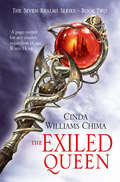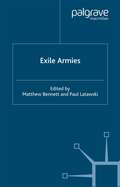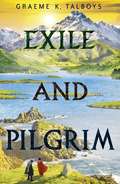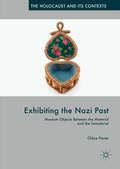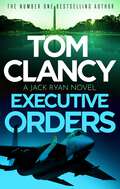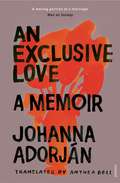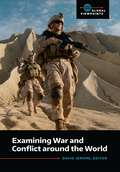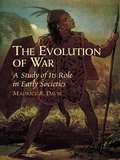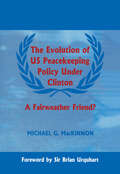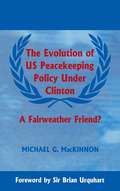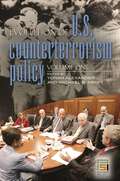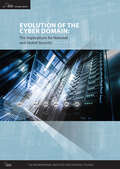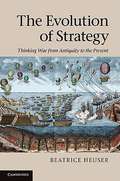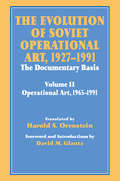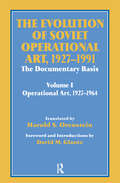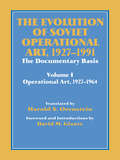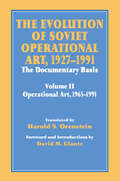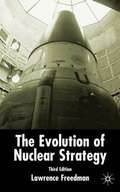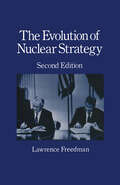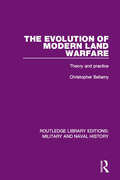- Table View
- List View
The Exiled Queen (The Seven Realms Series #2)
by Cinda Williams ChimaThe second book in an epic fantasy series from Cinda Williams Chima. Adventure, magic, war and ambition conspire to throw together an unlikely group of companions in a struggle to save their world.
Exile Armies
by P. Latawski M BennettOperating from outside their homelands, exile armies have been an understudied phenomenon in history and international politics. From avoiding the fate of being a mere tool for a patron power to facing issues regarding their military efficacy and political legitimacy, exiled armies have found their journey home a tortuous one. This collection of essays covers the experience of exiled forces in the Second World War, principally in Europe, and also covers their activities around the globe during the Cold War and beyond.
Exile and Pilgrim: Being The Second Adventure From The Chronicles Of Jeniche Of Antar (Shadow in the Storm #2)
by Graeme K. TalboysJeniche of Antar’s old life has a nasty habit of catching up with her.
Exhibiting the Nazi Past: Museum Objects Between the Material and the Immaterial (The Holocaust and its Contexts)
by Chloe PaverThis book is the first full-length study of the museum object as a memory medium in history exhibitions about the Nazi era, the Second World War, and the Holocaust. Over recent decades, German and Austrian exhibition-makers have engaged in significant programmes of object collection, often in collaboration with witnesses and descendants. At the same time, exhibition-makers have come to recognise the degree to which the National Socialist era was experienced materially, through the loss, acquisition, imposition, destruction, and re-purposing of objects. In the decades after 1945, encounters with material culture from the Nazi past continued, both within the family and in the public sphere. In analysing how these material engagements are explored in the museum, the book not only illuminates a key aspect of German and Austrian cultural memory but contributes to wider debates about relationships between the human and object worlds.
Exhibiting the Nazi Past: Museum Objects Between the Material and the Immaterial (The Holocaust and its Contexts)
by Chloe PaverThis book is the first full-length study of the museum object as a memory medium in history exhibitions about the Nazi era, the Second World War, and the Holocaust. Over recent decades, German and Austrian exhibition-makers have engaged in significant programmes of object collection, often in collaboration with witnesses and descendants. At the same time, exhibition-makers have come to recognise the degree to which the National Socialist era was experienced materially, through the loss, acquisition, imposition, destruction, and re-purposing of objects. In the decades after 1945, encounters with material culture from the Nazi past continued, both within the family and in the public sphere. In analysing how these material engagements are explored in the museum, the book not only illuminates a key aspect of German and Austrian cultural memory but contributes to wider debates about relationships between the human and object worlds.
Executive Orders (Jack Ryan #7)
by Tom Clancy'A top-notch novelist for anyone who loves a powerful story' Boston GlobeThe US President, along with most of the Cabinet and Congress, is dead. Dazed and confused, the man who only minutes before had been confirmed as the new Vice-President of the United States is told that he is now President.President John Patrick Ryan.With stunning force, Ryan's responsibilities crush on him. He must calm an anxious and grieving nation, all while attempting to reconstitute a Cabinet and a Congress with the greatest possible speed.But that is not all. Both within Washington DC and across the globe, there are those eager to act on the animosity towards the United States and others from Jack Ryan's past that harbour a grudge towards the new President himself. Soon they will present Jack Ryan with a crisis so big even he cannot imagine it.
An Exclusive Love: A Memoir
by Anthea Bell Johanna AdorjánOne Sunday morning in October, István and his wife Vera start their day as usual. They tidy their house; Vera makes a festive cake to put in the freezer and cuts fresh roses for a vase in the living room. That evening, after nearly fifty years of marriage, they lie down in their bed and take their own lives. Having survived the tumult of twentieth-century Europe and after raising a family together, they could not accept the words 'until death do us part'. While sifting through the fragments of the family history in an attempt to understand this glamorous and enigmatic couple, their granddaughter Johanna Adorján imagines their final day. Amid the family stories and portraits by friends, she dares to give voice to their never-mentioned experiences in the Holocaust and their escape from Hungary during the uprising of 1956.
Examining War and Conflict around the World (Global Viewpoints)
by David JeromeThis volume addresses 10 issues pertaining to war and conflict, such as ethics of war, national security, and refugees, and examines how countries around the world are facing these issues.To truly explore war and conflict, one must consider why the peoples and the leaders of the world behave the way that they do toward one another. For instance, why are refugees, in a variety of circumstances, treated so inhumanely in times of conflict and unrest through no fault of their own? How are women and those in the LGBTQ community treated in terms of service to their country? Examining War and Conflict around World includes ten chapters, each addressing a specific issue relating to war and conflict as it pertains to a variety of countries, including anti-Americanism, military robots and drones, nuclear weapons and proliferation, and torture. Each chapter begins with an introduction to the issue. Following the chapter introduction, each chapter highlights that issue in eight countries. Chapters provide historical perspective, but the book addresses each of the issues in a contemporary context. This work will provide an overview for all readers of ten very important topics that address matters relating to war and conflict in the twenty-first century.
Examining War and Conflict around the World (Global Viewpoints)
by David JeromeThis volume addresses 10 issues pertaining to war and conflict, such as ethics of war, national security, and refugees, and examines how countries around the world are facing these issues.To truly explore war and conflict, one must consider why the peoples and the leaders of the world behave the way that they do toward one another. For instance, why are refugees, in a variety of circumstances, treated so inhumanely in times of conflict and unrest through no fault of their own? How are women and those in the LGBTQ community treated in terms of service to their country? Examining War and Conflict around World includes ten chapters, each addressing a specific issue relating to war and conflict as it pertains to a variety of countries, including anti-Americanism, military robots and drones, nuclear weapons and proliferation, and torture. Each chapter begins with an introduction to the issue. Following the chapter introduction, each chapter highlights that issue in eight countries. Chapters provide historical perspective, but the book addresses each of the issues in a contemporary context. This work will provide an overview for all readers of ten very important topics that address matters relating to war and conflict in the twenty-first century.
Ex-Combatants and International Statebuilding: Veterans as Peace Brokers in Kosovo (Routledge Studies in Intervention and Statebuilding)
by Nathalie DuclosThis book examines the international efforts to regulate violence in Kosovo since 1999 through the United Nations Mission in Kosovo (UNMIK) and covers 15 years of international presence.The book analyses the process of implementing international policies from a sociological perspective, and looks at the adaptations and arrangements of public policies achieved through the transactions of international actors with local actors, who are at the heart of policy implementation. In particular, it analyses the disarmament, demobilisation, and reintegration of combatants (DDR) programme and shows the extent to which it was co-produced with Kosovo Liberation Army (KLA) leaders co-opted by international administrators. These analyses take the opposite view to the work that considers ex-combatants as spoilers. In Kosovo, the combatant leaders acted as peace brokers, facilitating demobilisation and exercising disciplinary control over rank-and-file combatants. Their position as brokers helped them to take control of the new state being built under international administration. This book shows the importance of the relationship between ex-combatants and the state and illustrates the multiplicity of their possible trajectories, including political ones. To elucidate the dynamics of co-production in shaping DDR policies and hybridising international policies as well as in state formation, the book relies on around a hundred interviews with ex-combatants of the KLA and with international personnel, as well as on the archives of international organisations and observations in the field.This book will be of much interest to students of international statebuilding, peace and conflict studies, Balkan politics and international relations.
Ex-Combatants and International Statebuilding: Veterans as Peace Brokers in Kosovo (Routledge Studies in Intervention and Statebuilding)
by Nathalie DuclosThis book examines the international efforts to regulate violence in Kosovo since 1999 through the United Nations Mission in Kosovo (UNMIK) and covers 15 years of international presence.The book analyses the process of implementing international policies from a sociological perspective, and looks at the adaptations and arrangements of public policies achieved through the transactions of international actors with local actors, who are at the heart of policy implementation. In particular, it analyses the disarmament, demobilisation, and reintegration of combatants (DDR) programme and shows the extent to which it was co-produced with Kosovo Liberation Army (KLA) leaders co-opted by international administrators. These analyses take the opposite view to the work that considers ex-combatants as spoilers. In Kosovo, the combatant leaders acted as peace brokers, facilitating demobilisation and exercising disciplinary control over rank-and-file combatants. Their position as brokers helped them to take control of the new state being built under international administration. This book shows the importance of the relationship between ex-combatants and the state and illustrates the multiplicity of their possible trajectories, including political ones. To elucidate the dynamics of co-production in shaping DDR policies and hybridising international policies as well as in state formation, the book relies on around a hundred interviews with ex-combatants of the KLA and with international personnel, as well as on the archives of international organisations and observations in the field.This book will be of much interest to students of international statebuilding, peace and conflict studies, Balkan politics and international relations.
The Evolution of War: A Study of Its Role in Early Societies
by Maurice R. DavieThorough, highly informative and exhaustive study presents an exceptional collection of cases examining such topics as warfare as the business of one sex, religion as a cause of war, and war for the sake of glory. Cannibalism, human sacrifice, blood-revenge, and other factors in warfare among primitive peoples are also expertly examined.
The Evolution of US Peacekeeping Policy Under Clinton: A Fairweather Friend?
by Michael G. MacKinnonThis fascinating study examines the dynamic process through which the Clinton administration developed a policy towards UN peace support operations. The author addresses the fundamental question: what factors influenced the shift in US policy towards the United Nations and its peace support operations and which factors were clearly dominant?Based on primary sources and interviews with political personalities and officials, the author examines four main factors which shaped the development of policy: the Executive branch, the bureaucracies (the State Department and Department of Defense), Congress and public opinion. These provide the basis for the core chapters of the book, which also contains a chapter on methodology and a chapter of summary analysis.
The Evolution of US Peacekeeping Policy Under Clinton: A Fairweather Friend?
by Michael G. MacKinnonThis fascinating study examines the dynamic process through which the Clinton administration developed a policy towards UN peace support operations. The author addresses the fundamental question: what factors influenced the shift in US policy towards the United Nations and its peace support operations and which factors were clearly dominant?Based on primary sources and interviews with political personalities and officials, the author examines four main factors which shaped the development of policy: the Executive branch, the bureaucracies (the State Department and Department of Defense), Congress and public opinion. These provide the basis for the core chapters of the book, which also contains a chapter on methodology and a chapter of summary analysis.
Evolution of U.S. Counterterrorism Policy [3 volumes]: [3 volumes] (Praeger Security International)
by Yonah Alexander Michael KraftIncluding many older documents not available electronically or otherwise accessible, this three-volume set provides the first comprehensive collection of key documents, statements, and testimony on U.S. government counterterrorism policies as they have evolved in the face of the changing terrorist threats. Selected executive and congressional materials highlight the government's diverse policy and program responses to terrorism. The testimony, statements, and documents provide the public articulation and face to the largely important intelligence, law enforcement, preventative security measures, and international cooperation used in the shadowy war against terrorism. Recent entries provide a handy compilation of important post-9/11 materials. For example, useful background information on U.S. actions against Osama bin Laden, the Taliban, and Saddam Hussein and terrorism fundraising. Also included are statements from the Reagan and other administrations that relate to disputes over the appropriate use of force. Introductory chapters by Alexander and Kraft provide the historical context and analysis of previous and current U.S. counterterrorism policy including U.S. legislation.For over two centuries, America has faced occasional outbreaks of terrorism, perpetrated by both indigenous and foreign groups. But the spectacular bombing in Oklahoma City in 1995 and the September 11, 2001, attacks seemed to signify a new age, frightening many Americans and destroying their sense of domestic security. In addition, U.S. citizens and interests have been increasingly affected by acts of terrorism abroad. The challenges of terrorism, therefore, have required the United States to develop comprehensive strategies and programs to counter both conventional and unconventional threats, nationally and globally.
Evolution of the Cyber Domain: The Implications for National and Global Security
by The International Institute for Strategic StudiesCyber security has become a focal point for conflicting domestic and international interests, and increasingly for the projection of state power. The military utility of the cyber domain is linked to the economic and social potential of information and communications technologies (ICTs), while technologies with military and national-security applications have become essential to the conduct of modern life.In light of this, Evolution of the Cyber Domain provides a holistic review of the strategic, operational and technical issues at the centre of the international cyber-security debate. The Dossier charts and contextualises the key developments and trends that have shaped the cyber domain since the 1950s. As well as tracking the events and decisions underlying the military potential of ICTs, it examines the issues and policies that affect global governance of the internet.The Dossier analyses:• The geopolitics of international cyber security and technological development.• The challenges of creating methods for managing conflict within the cyber domain based on international law.• The tension between issues of privacy, freedom of information and national security.• Intelligence as a state practice in peace and war.• The development and use of cyber military capabilities.The Dossier is an important point of reference for further research and analysis on complex cyber-security issues, and it provides a series of insights into national positions, as well as regional and global agreements and policies. Evolution of the Cyber Domain is a useful resource for readers who seek a comprehensive picture of cyber affairs, and who wish to understand the social, economic and politico-military challenges that have guided the development and use of ICTs in the past six decades. By summarising the ways in which governments are addressing these challenges at the strategic level, it helps prepare decision-makers and researchers involved in the formulation of cyber-security policy, strategy and analysis. The Dossier also contains a glossary of the key terms and concepts in the cyber-security dialogue.
Evolution of the Cyber Domain: The Implications for National and Global Security
by Eneken Tikk-RingasCyber security has become a focal point for conflicting domestic and international interests, and increasingly for the projection of state power. The military utility of the cyber domain is linked to the economic and social potential of information and communications technologies (ICTs), while technologies with military and national-security applications have become essential to the conduct of modern life.In light of this, Evolution of the Cyber Domain provides a holistic review of the strategic, operational and technical issues at the centre of the international cyber-security debate. The Dossier charts and contextualises the key developments and trends that have shaped the cyber domain since the 1950s. As well as tracking the events and decisions underlying the military potential of ICTs, it examines the issues and policies that affect global governance of the internet.The Dossier analyses:• The geopolitics of international cyber security and technological development.• The challenges of creating methods for managing conflict within the cyber domain based on international law.• The tension between issues of privacy, freedom of information and national security.• Intelligence as a state practice in peace and war.• The development and use of cyber military capabilities.The Dossier is an important point of reference for further research and analysis on complex cyber-security issues, and it provides a series of insights into national positions, as well as regional and global agreements and policies. Evolution of the Cyber Domain is a useful resource for readers who seek a comprehensive picture of cyber affairs, and who wish to understand the social, economic and politico-military challenges that have guided the development and use of ICTs in the past six decades. By summarising the ways in which governments are addressing these challenges at the strategic level, it helps prepare decision-makers and researchers involved in the formulation of cyber-security policy, strategy and analysis. The Dossier also contains a glossary of the key terms and concepts in the cyber-security dialogue.
The Evolution Of Strategy: Thinking War From Antiquity To The Present (PDF)
by Beatrice HeuserIs there a 'Western way of war' which pursues battles of annihilation and single-minded military victory? Is warfare on a path to ever greater destructive force? This magisterial account answers these questions by tracing the history of Western thinking about strategy - the employment of military force as a political instrument - from antiquity to the present day. Assessing sources from Vegetius to contemporary America, and with a particular focus on strategy since the Napoleonic Wars, Beatrice Heuser explores the evolution of strategic thought, the social institutions, norms and patterns of behaviour within which it operates, the policies that guide it and the cultures that influence it. Ranging across technology and warfare, total warfare and small wars as well as land, sea, air and nuclear warfare, she demonstrates that warfare and strategic thinking have fluctuated wildly in their aims, intensity, limitations and excesses over the past two millennia. 9780521155243
The Evolution of Soviet Operational Art, 1927-1991: The Documentary Basis: Volume 2 (1965-1991) (Soviet (Russian) Study of War)
by David M. Glantz Harold S. OrensteinThe Soviet military concept of operational art and the associated theories such as "war of annihilations", "deep battle", and "deep operations" have been observed by the West since World War II. The Soviet government hid their military-theoretical work behind a veil of secrecy. Here, the Soviet theories are revealed in the words of those who created them in peacetime and applied them in war.
The Evolution of Soviet Operational Art, 1927-1991: The Documentary Basis: Volume 1 (Operational Art 1927-1964) (Soviet (Russian) Study of War #No. 6-7)
by David M. Glantz Harold S. OrensteinThis collection of texts has been taken from formerly classified material in the official Red Army General Staff journal 'Military Thought'. The results are two volumes of great scope based on archival evidence. They stand as a compulsory reference point for anyone with an interest in the operational endeavours of the Soviet Army from the 1920's onward.
The Evolution of Soviet Operational Art, 1927-1991: The Documentary Basis: Volume 1 (Operational Art 1927-1964) (Soviet (Russian) Study of War)
by David M. Glantz Harold S. OrensteinThis collection of texts has been taken from formerly classified material in the official Red Army General Staff journal 'Military Thought'. The results are two volumes of great scope based on archival evidence. They stand as a compulsory reference point for anyone with an interest in the operational endeavours of the Soviet Army from the 1920's onward.
The Evolution of Soviet Operational Art, 1927-1991: The Documentary Basis: Volume 2 (1965-1991) (Soviet (Russian) Study of War #No. 6-7)
by David M. Glantz Harold S. OrensteinThe Soviet military concept of operational art and the associated theories such as "war of annihilations", "deep battle", and "deep operations" have been observed by the West since World War II. The Soviet government hid their military-theoretical work behind a veil of secrecy. Here, the Soviet theories are revealed in the words of those who created them in peacetime and applied them in war.
Evolution of Nuclear Strategy (PDF)
by Lawrence FreedmanFirst published twenty years ago, Lawrence Freedman's Evolution of Nuclear Strategy was immediately acclaimed as a seminal work on the history of attempts to cope militarily and politically with the terrible destructive power of nuclear weapons. This new edition takes the story beyond the end of the cold war, through the Gulf War and new arguments about missile defence and 'rogue states', up to the impact of the events of 11 September 2001. While the removal of the Warsaw Pact from the scene brought to an abrupt end many of the debates that had dominated strategic discourse for the previous four decades, the basic question of whether or not this destructive power could be used for political ends, and how best to stop others trying to do so, remained. In one volume the reader can trace the story of nuclear strategy from its roots in thinking about airpower in the first decades of the Twentieth Century to arguments about how to deal with the possibility of nuclear terrorism in the Twenty-First. There is full coverage of how the west came to rely on nuclear weapons to deter Soviet aggression and the major problems of credibility that soon opened up as the Soviet Union developed its own nuclear capability. The highlights of the ensuing strategic debate are described, and the contributions of the leading figures in these debates are examined. The extent to which the theorising influenced the formation of policy in the major nuclear powers is explored. At all times the wider political context is kept in view, demonstrating the factors which shaped the nuclear legacy with which each new generation must cope.
The Evolution of Nuclear Strategy (Studies in International Security)
by Lawrence Freedman'...Lawrence Freedman has provided a masterly account of the evolution of nuclear strategic thought which is steeped in scholarship, elegantly written, and comprehensive in scope.' Edward M.Spiers, Times Higher Education Supplement
The Evolution of Modern Land Warfare: Theory and Practice (Routledge Library Editions: Military and Naval History)
by Christopher BellamyExtensively illustrated with 52 detailed campaign and battle maps and diagrams, this book, originally published in 1990, surveys the evolution of warfare in Europe from Napoleon to the end of the twentieth century and in Asia from the Middle Ages. It considers the interaction of technology and warfare. With wide-ranging examples, the book includes two in depth case studies, one on the Soviet Operational Manoeuvre Group and its predecessors in the Russian Imperial Army, the other on the history of land warfare, including guerilla warfare, in Asia. In this book the author demonstrates that military history can be of immense practical help to the modern military analyst and professional. Now updated with a new introduction to take into account changes since 1990, this book remains of essential value to students, teachers & professionals in political & social history, international relations, defence, war & peace studies.
